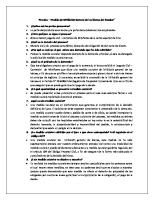P2 - BDD
Practice 2 Solutions DECLARE v_weight NUMBER(3) := 600; v_message VARCHAR2(255) := 'Product 10012'; BEGIN /*SUBBLOCK
Views 109 Downloads 1 File size 49KB
Recommend stories
- Author / Uploaded
- Xavi Núñez Siñol
Citation preview
Practice 2 Solutions DECLARE v_weight
NUMBER(3) := 600;
v_message
VARCHAR2(255) := 'Product 10012';
BEGIN /*SUBBLOCK*/ DECLARE v_weight
NUMBER(3) := 1;
v_message
VARCHAR2(255) := 'Product 11001';
v_new_locn
VARCHAR2(50) := 'Europe';
BEGIN v_weight := v_weight + 1; v_new_locn := 'Western ' || v_new_locn;
1
END; v_weight := v_weight + 1; v_message := v_message || ' is in stock'; v_new_locn := 'Western ' || v_new_locn;
2
END; / 1. Evaluate the PL/SQL block above and determine the data type and value of each of the following variables according to the rules of scoping. a. The value of V_WEIGHT at position 1 is: 2 The data type is NUMBER. b.
The value of V_NEW_LOCN at position 1 is: Western Europe The data type is VARCHAR2.
c.
The value of V_WEIGHT at position 2 is: 601 The data type is NUMBER.
d.
The value of V_MESSAGE at position 2 is: Product 10012 is in stock The data type is VARCHAR2.
e.
The value of V_NEW_LOCN at position 2 is: Illegal because v_new_locn is not visible outside the subblock.
Oracle9i: Program with PL/SQL A-5
Practice 2 Solutions (continued) Scope Example DECLARE v_customer
VARCHAR2(50) := 'Womansport';
v_credit_rating
VARCHAR2(50) := 'EXCELLENT';
BEGIN DECLARE v_customer
NUMBER(7) := 201;
v_name VARCHAR2(25) := 'Unisports'; BEGIN v_customer
v_name
v_credit_rating
v_name
v_credit_rating
END; v_customer END; /
Oracle9i: Program with PL/SQL A-6
Practice 2 Solutions (continued) 2. Suppose you embed a subblock within a block, as shown on the previous page. You declare two variables, V_CUSTOMER and V_CREDIT_RATING, in the main block. You also declare two variables, V_CUSTOMER and V_NAME, in the subblock. Determine the values and data types for each of the following cases. a. The value of V_CUSTOMER in the subblock is: 201 The data type is NUMBER. b. The value of V_NAME in the subblock is: Unisports and The data type is VARCHAR2. c. The value of V_CREDIT_RATING in the subblock is: EXCELLENT The data type is VARCHAR2. d. The value of V_CUSTOMER in the main block is: Womansport The data type is VARCHAR2. e. The value of V_NAME in the main block is: V_NAME is not visible in the main block and you would see an error. f. The value of V_CREDIT_RATING in the main block is: EXCELLENT The data type is VARCHAR2.
Oracle9i: Program with PL/SQL A-7
Practice 2 Solutions (continued) 3. Create and execute a PL/SQL block that accepts two numbers through iSQL*Plus substitution variables. a. Use the DEFINE command to provide the two values. DEFINE p_num1=2 -- example DEFINE p_num2=4 -- example b. Pass these two values defined in step a above, to the PL/SQL block through iSQL*Plus substitution variables. The first number should be divided by the second number and have the second number added to the result. The result should be stored in a PL/SQL variable and printed on the screen. Note: SET VERIFY OFF in the PL/SQL block. SET ECHO OFF SET VERIFY OFF SET SERVEROUTPUT ON DECLARE v_num1
NUMBER(9,2) := &p_num1;
v_num2
NUMBER(9,2) := &p_num2;
v_result
NUMBER(9,2) ;
BEGIN v_result :=
(v_num1/v_num2) + v_num2;
/* Printing the PL/SQL variable */ DBMS_OUTPUT.PUT_LINE (v_result); END; / SET SERVEROUTPUT OFF SET VERIFY ON SET ECHO ON
Oracle9i: Program with PL/SQL A-8
Practice 2 Solutions (continued) 4.
Build a PL/SQL block that computes the total compensation for one year. a. The annual salary and the annual bonus percentage values are defined using the DEFINE command. b.
Pass the values defined in the above step to the PL/SQL block through iSQL*Plus substitution variables. The bonus must be converted from a whole number to a decimal (for example, 15 to .15). If the salary is null, set it to zero before computing the total compensation. Execute the PL/SQL block. Reminder: Use the NVL function to handle null values. Note: Total compensation is the sum of the annual salary and the annual bonus.
Method 1: When an iSQL*Plus variable is used: a. VARIABLE g_total NUMBER DEFINE p_salary=50000 DEFINE p_bonus=10 b. SET VERIFY OFF DECLARE v_salary NUMBER := &p_salary; v_bonus NUMBER := &p_bonus; BEGIN :g_total := NVL(v_salary, 0) * (1 + NVL(v_bonus, 0) / 100); END; / PRINT g_total SET VERIFY ON Alternate Solution: When a PL/SQL variable is used: a. DEFINE p_salary=50000 DEFINE p_bonus=10 b.
SET VERIFY OFF SET SERVEROUTPUT ON DECLARE v_salary NUMBER := &p_salary; v_bonus NUMBER := &p_bonus; BEGIN dbms_output.put_line(TO_CHAR(NVL(v_salary, 0) * (1 + NVL(v_bonus, 0) / 100))); END; / SET VERIFY ON SET SERVEROUTPUT OFF
Oracle9i: Program with PL/SQL A-9









